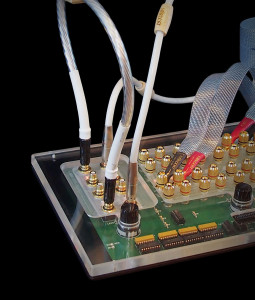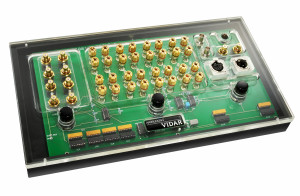From anti-static treatment to cable elevators, there are several things one can do to maximize the performance level of audio cables. For years now, manufacturers have been aware of another practice that drastically improves upon performance that has recently been gaining acceptance from hifi enthusiasts: cable burn-in.
Any listener will be able to identify a marked change in audio equipment within the first 100 hours of use (whether it be a new cable, component or loudspeaker). But what is the reason for these improvements and what can be done to facilitate this process?
During the manufacturing process, as insulation is extruded over the conductors, gases can become trapped. This combined with the high electrical charges often found in new cables, result in a brittle and bright sound that lacks the detail and depth desired for music reproduction. There are a few ways to solve this problem. One way to burn-in your cables is to simply hook them up in your home audio system and play music for a minimum of 100 hours. Even better, use a burn in disc, like Nordost’s System Set-Up & Tuning Disc, which provides a track specifically designed to produces a range of tones that stress the cables and expedite the burn-in process. However, the best solution is to treat your cables using a designated cable burn-in device such as Nordost’s Vidar.
When cables are first put into use, their directionality is not securely established. However, once the Vidar begins running current through the cables, the trapped gases are dissipated and small impurities in the conductor’s metal begin to act like a diode, favoring current flow in a particular direction. By using extremely wide bandwidth signal as well as a range of both ultra-low and high frequency sweeps, the Vidar stresses the conductors, neutralizes charges, improves the way that signals pass through metal and ultrasonically conditions the surface of the conductors. It is these changes in both the conductor and insulation material that refines performance in audio cables.
While it is most important to implement burn-in upon purchase, there is something to be gained from routine maintenance as well. If cables are left unused for a prolonged period of time they become stagnant. And even through everyday cable use, electrical equipment experiences current leakage, imparting a charge onto your cables. By having your cables treated with the Vidar you are treating your cables with the Vidar you are conditioning them and allowing the charges to neutralize once again.
This service is only available through authorized Nordost dealers.To locate the Nordost dealer nearest you, please consult the “Where to Buy” page of our website.



I get lots of my home audio stuff on Bojams.com. Love that site.
Given that audio signals are AC, how does the OUT->IN direction matter on a reversible cable?
the «directionality» of the cable reflects the souce end of the cable where the «floating ground wire» is connected – i.e. a drain wire whose purpose is to bring unwanted interference signals to ground so that it does NOT get to the output.
It doesn’t; it’s imaginary and is used to sell products. Can’t be measured? Then it doesn’t exist or is insignificant.
I love the idea that if something can’t be measured it doesn’t exist. do you think humans are currently able to measure every signal that exists?
Absolutely. Signal that goes through cable is electric current. All kind of electric current fluctuations can be measured. Those who think differently are, let it me put this way: naive!
Since these cables are made by manufacturers, it should be the manufacturers to do this before selling their product.
What is the optimal time for cable burn in utilizing the Vidar?
Does it differ by cable length and type?
The optimal time doesn’t factor into cable type per se, but more on cable construction. For example, non mono-filament cables take approximately 96 hours on the Vidar to break in. Mono-filament designs take approximately 120 hours, and dual mono-filament cables take 210 hours on a Vidar.
Pingback: Burn in loudspeaker cable. Best Audiophile Cables Online.
What an absolute load of Tosh, cable burn in I’ve heard it all.
There are numerous studies online which point to a metal coat hanger being no different sound wise, an electrical cable is just as good as cable costing many thousands £££’s of pounds.
This is the problem with society we just fritter away money, vital resource and resources on utter nonsense.
Hi,
My dealer burned in the Frey speaker cables with your machine for 92 hours.
Should I expect to have some burn in time on my system as well?
Thanks-Bob
In terms of “break-in” time, the answer would be no. A fully burned-in cable on a Vidar will be totally ready for use in a system…unless those burned-in cables go into storage before getting installed afterward. However, there is a second aspect of the installation of new cables which is called “settling” time. When you install cables in a system, they typically require 5-7 days to “settle” before being fully optimized.
Hi,
I have since 15 days my first Nordost products:
2 QB8 connected each with a 2 meters Valhalla 2 main cable.
This gives power to an active system (that’s why the 2 QB8).
Same dealer for the system and the Nordost products.
From the beginning, there is a lot more air and details.
But the sound change a lot:
– extremely open, real, nice and impressive :-)))
– like the air was “over-charged”, with also too much highs, so not very pleasing,
– totally out, as the music seems not in the right order like a wrong puzzle…
This comes and go, so you can have an extraordinary listening one day, and 2 days after the same disc seems completely broken.
I suppose this is burn-in, but could you confirm my experience is normal?
Second questions: burn-in needs signal, I suppose.
If no signal (between 2 listenings) the burn-in stop?
Does a disc in repeat mode at very low level during the night is OK, and sufficient?
Thank you.
Cheers,
Chris
Thank you for your question. The short answer is no, what you are describing is not a typical experience for cable burn in. The burn in process is linear, so it wouldn’t get better and then get worse.
First, there are two parts to the break-in process, the burn-in, and the settling-in. The burn-in process is a gradual process and can take several weeks if you are trying to do it in a system, instead of on a Vidar. The cables start off a bit harsh and gradually get smoother as they break-in. They get better in all attributes, but the smoothness is the most noticeable.
Then, there is settling, which occurs over a 5-6 day period. As the cables stay stationary, the imaging starts to focus. This is why you don’t want to do hardcore evaluations unless the cables have been motionless/had a chance to settle for a while.
For your second question: yes, a signal has to pass between components for the burn-in process to start. You can accelerate it with burn-in tracks that many test CDs, including ours, have.
Thanks for your response.
The system is really untouched since 1 week, but the mains and QB8 are connected to the wall since 2 weeks.
So, since 1 week, only the cables changed the sound : alternatively in a good way and in a less good way. It was very obvious to listen.
Since 2 days, it is brilliant 🙂
So, I’m confident now that it will stabilize like that…
Where can I buy your CD, in France? On Amazon?
Thanks again.
Cheers,
Chris
All Nordost products, including our System Solution Set-Up and Burn-In CD are only available at authorized Nordost dealers. Here is the list of Where To Buy Nordost in France!
How about the Heimdall 2 Ethernet ? I just purchased 2 x 2 meter strands . Does burn in time offer improvement?
It does! The Vidar 2, available at many Nordost dealers have a specific Ethernet burn-in setting